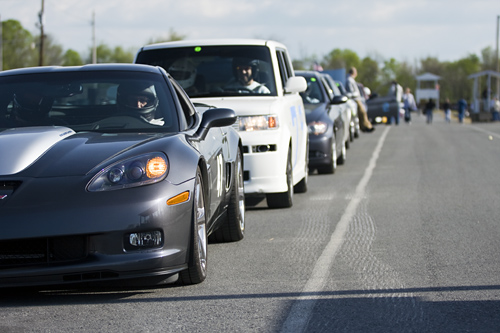HPDE

You have always wanted to know what “she could do”, but you know the streets and highways are not the place. NASA gives you and your car an easy, safe, and affordable way to get on the track! No speed limits, no pedestrians, but best of all-no tickets. The NASA High Performance Driving Event provides you with an experienced racer to help guide you through the event, one on one, as you learn how to handle your car at the limit. You set your own goals and go as fast as you feel comfortable going. You can progress as far as you want; after plenty of HPDE experience you can enter the Time Trial group, become a certified instructor, or even get a competition license and go racing.
How?
Basically, all you need is a safe car and a helmet.The car does not have to be fancy or fast. Students bring everything from a Hyundai to a Ferrari. Read the requirements for the other miscellaneous items required below.
Who?
Anyone who is a member of NASA (or a NASA sanctioned car club) may participate. Minimum age is 18 (16 with parental consent). Many different types of people enter our events. The number of women who are taking our courses has steadily increased and most are very eager to enhance their driving skills. A lot of husbands and wives also team up and use only one car which makes it a little bit more convenient. There are many teenagers and young adults who receive a school entry compliments of their parents who want to teach their kids to be safer drivers. Note- All passengers must be at least 18 years old. Please see the Club Codes and Regulations.
Group Levels:
We have four HPDE groups, which means we run four groups of cars on the track in three to four sessions each per day. Sessions last approximately 20 to 30 minutes, depending upon the event. Run groups are based almost entirely on driver experience and skill, and each one contains about 15 cars per mile of track.
Group 1: “Novice” drivers are those who have driven at zero or very few track days and have never been “signed off” by an instructor for solo track driving. Signing up for Group 1 requires an instructor. Passing other cars in Group 1 is only allowed on straights and only after the driver of the lead car signals that it’s safe to pass.
Group 2: “Intermediate” drivers are those who have driven at some track days on at least one track and have been “signed off” by an instructor on at least one track. Signing up for Group 2 requires an instructor. Passing other cars in Group 2 is only allowed on straights after the driver of the lead car signals.
Group 3: “Advanced” drivers are those who have participated at 10 track days on more than one track and have been “signed off” by an instructor for each track driven. Group 3 drivers can request instructors at additional cost. Passing other cars in Group 3 is only allowed after the driver of the lead car signals but may be done anywhere on the track.
Group 4: “Instructors” are those who have participated and completed Instructor Certification clinics we hold at various events each year. Passing other cars in Group 4 is only allowed after the driver of the lead car signals but may be done anywhere on the track.
Climbing the HPDE Ladder:
Solo-ing: To “Solo” is to have the opportunity to practice the skills and lessons imparted by the NASA curriculum without having an in-car instructor present in the car. Only when a student has demonstrated an acceptable awareness, judgment and car control skill will an instructor allow a student to “solo”. How quickly a driver gets “soloed” is purely dependent upon the progress made by the individual driver.
Advancing from one HPDE group to another: NASA Mid Atlantic sets certain milestones that much be reached in each HPDE level. How quickly a driver advanced to a higher HPDE level is purely dependent upon the progress made by the individual driver and the desire of the driver to advance. Moving up the ladder usually requires a written recommendation from at least one instructor and probably also a “check ride” with an instructor or designated member of the NASA staff.
Our Instructors:
Instructors are required for drivers in Groups 1 and 2 because they are very effective at relaying all levels of information while showing drivers both the fastest and safest way to get around the track. NASA instructors must attend clinics to get and keep their certification, and must follow a standardized curriculum. This standardization is the key to keeping NASA events the safest because it assures that all students are following the same rules on the track. All instructors must participate in continuing educations on-track sessions during each weekend they instruct and NASA sets aside a dedicated group of on track sessions in the HPDE 4 run group. Many NASA instructors are employed part-time by professional driving schools and other track organizations. Most trade their services for track time in Group 4 (aka the special Instructor group).
HPDE Pre-Tech Form:
Click here to download and view the HPDE Pre-Tech form. Please arrive at the track with this form filled out by a qualified inspector, and signed.
HPDE Requirements:
-Membership in NASA or a NASA sanctioned club
-Any car in safe operating condition (from Ferrari to Hyundai)
-Mufflers. Different tracks have different sound policies
-Roll bars in convertible autos
-Seat belts in good working order
-State driver’s license
-Long sleeve shirt and pants (cotton is great)
-A helmet (loaners are usually available, please inquire)
-Knowledge of the Club Codes and Regulations
-At least 18 years of age (16 w/parental consent)
HPDE Articles:
Read what NASA members have said about the HPDE experience…
Rollover Protection (convertibles)
